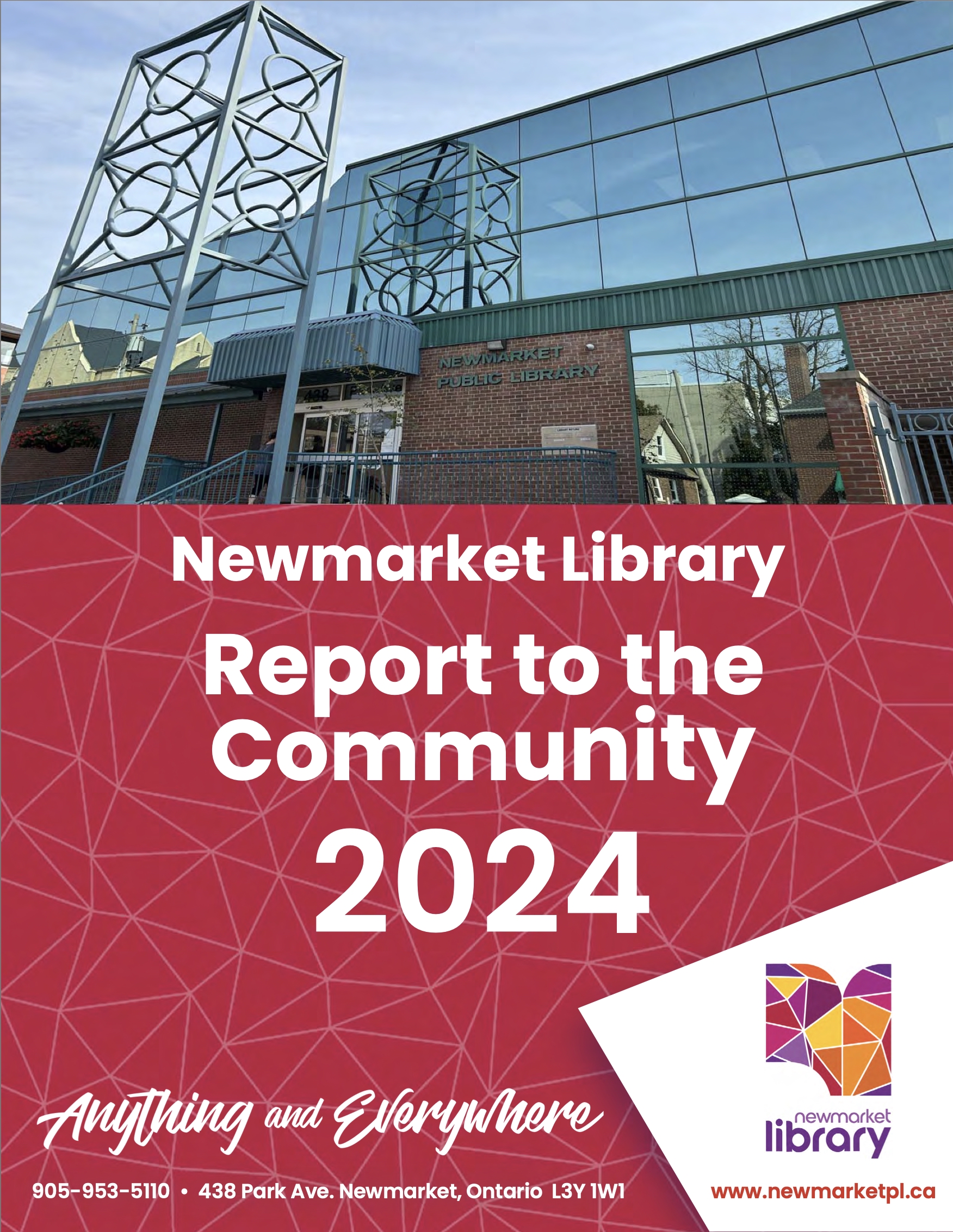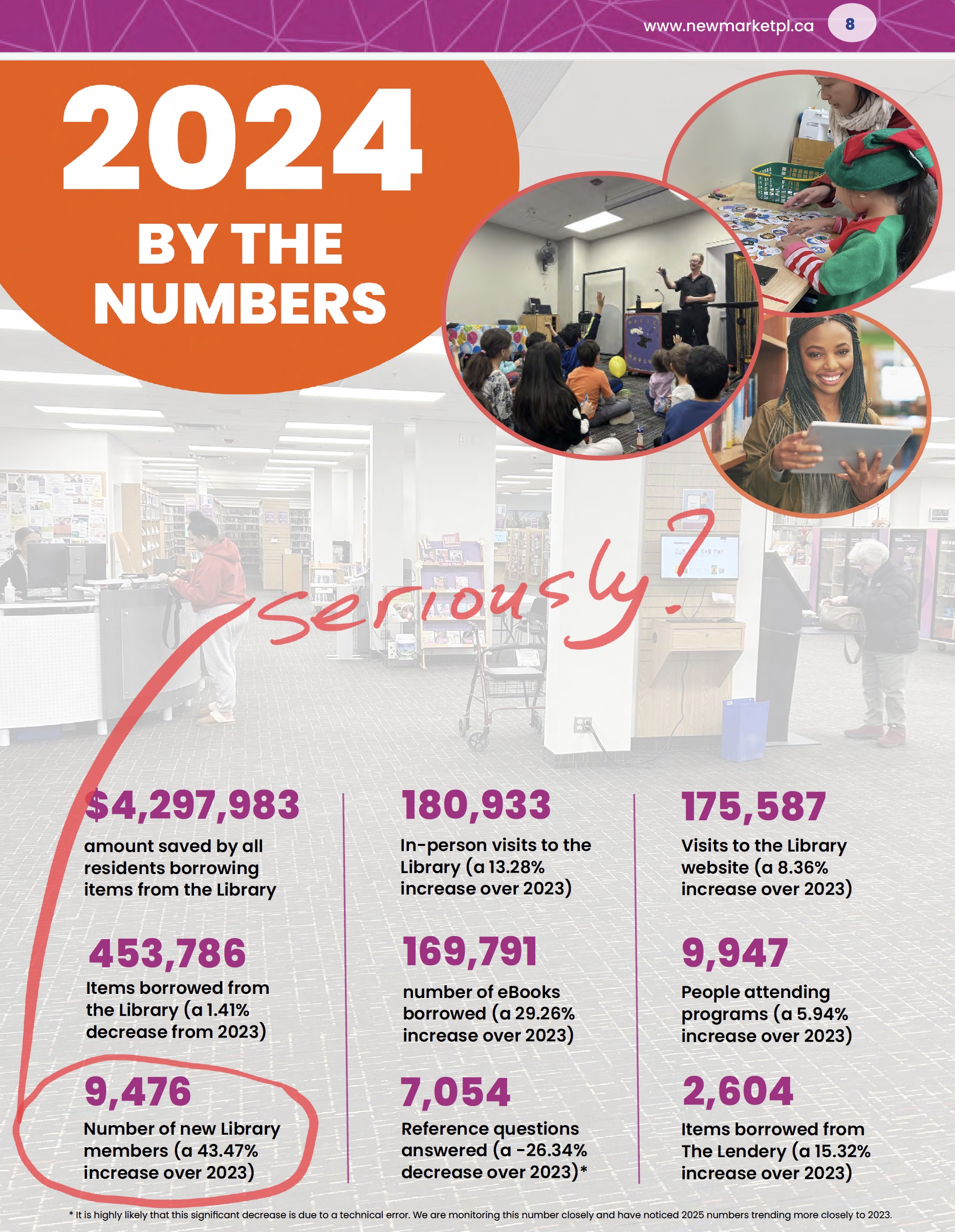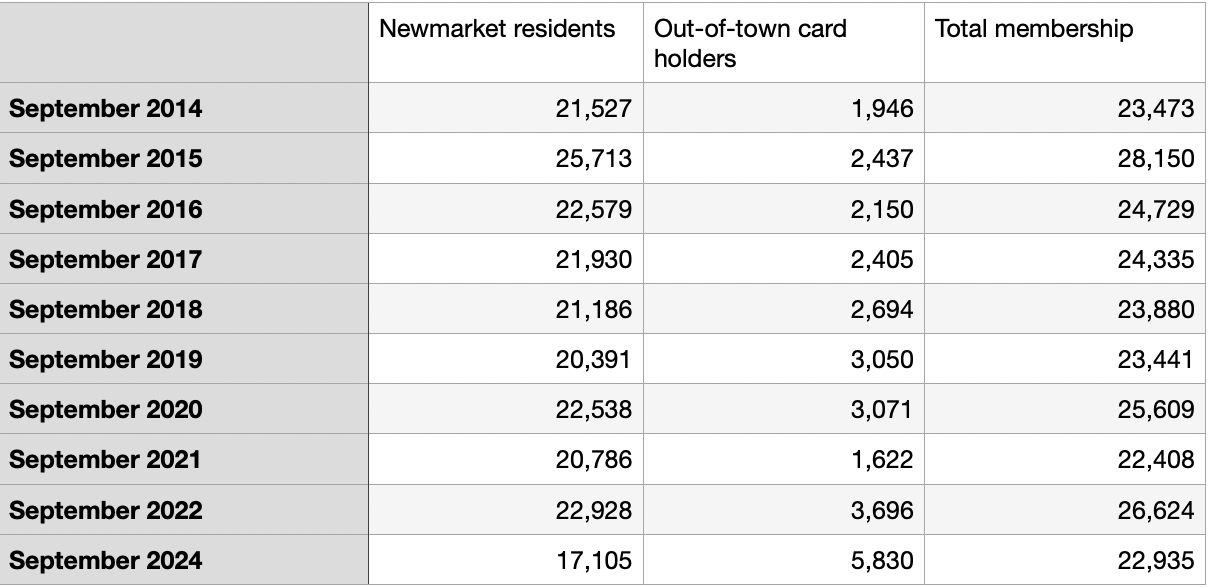Newmarket Public Library’s membership rocketed last year by an eye-watering 9,476 new members. We are told this was a 43.47% increase on 2023. 
These figures remind me of the old tractor production statistics we used to get from the former Soviet Union.
So good they can’t possibly be true.
The Library’s Chief Executive, Tracy Munusami, will be giving a presentation to Newmarket councillors on Monday (7 April 2025) on the Library’s annual Report to the Community 2024 and I shall be interested to hear what she has to say.
Amazing!
In the time she has been in charge I have grown used to Ms Munusami’s well-polished library lingo.
Everything is amazing, exciting and extraordinary.
So when Library Board chair, Darryl Gray, told us in the foreword to the Library’s latest Report to the Community that 2024 had been extraordinary and membership had grown significantly I had to take a second look.
“This past year has been extraordinary for the Newmarket Library, marked by significant growth in membership and an expanded presence throughout our community.”
Where did the 9,476 new members come from?
It wasn’t from the Library’s outreach programme which saw “new card memberships” increase by 595 in 2023 and 1,543 in 2024.
A simple request. Can we have the number of library members for 2024 and for 2023?
Comparisons
It’s not an easy job tracking down the figures. We used to get detailed statistics on library usage in a time series that allowed us to compare performance over the years. But that’s all been thrown out of the window. 
In the latest Report to the Community we see, for the most part, amazing percentage increases in Library usage from 2023. And where, unusually, we see a 26.34% decrease in “reference questions answered” we are told:
“it is highly likely that this significant decrease is due to a technical error”.
Significant increase
It may well be that these “new members” are simply former members rejoining the library after the COVID pandemic. Perhaps the library suspended membership renewals during COVID. But if that is the case then the “significant” increase in membership should be labelled as such.
I wrote to Ms Munusami last December about the Library’s outreach work and about the huge increase in the number of “out-of-town” members.
In September 2024 the number of out-of-town members (5,830) was more than a quarter of the total membership which, at that point, was 22,935.
I asked her:
“What explains the very significant increase in out-of-town members in 2024? In speaking to your counterparts in neighbouring libraries, is this surge in out-of-town members something that they too are experiencing?”
She told me:
“Over 3.9 million Ontarians, or nearly 27% of the population, hold a public library card. Collectively, the goal across Ontario public libraries is to provide equity of access to information and contribute to education, literacy and life-long learning. This starts with getting more people through library doors, which is why we open ours.
The Newmarket Library has a long-standing reciprocal borrowing agreement with York Region Libraries, Bradford West Gwillimbury Library and Brock Township Libraries.
We have removed barriers to open up our membership system so our library is accessible to anyone who may come through its doors. This included removing fines and welcoming our out-of-town neighbours to become members.
We also know that Newmarket is a regional hub that brings people into our community for shopping, recreation and culture programs, and healthcare, which in turn may bring more people into our library.
In speaking with library counterparts, we all take a similar open-door approach, so much so that many libraries do not distinguish out-of-town users within the data they capture.
The Library receives funding from the province in addition to municipal funding.”
Her reply didn’t really answer my question.
Free membership, Province wide 
Newmarket library now allows free membership to anyone living in Ontario. That means non-residents can borrow what they like and sign up to services such as Hoopla which costs the Library money for each item borrowed.
This is a different approach from many other libraries in Ontario. They charge non-residents fees unless reciprocal arrangements apply. For example, Bradford and West Gwillimbury charge $60 a year; East Gwillimbury $40; Toronto $150; Hamilton $100; Burlington $63 and so on.
Our neighbour, Aurora, charges an annual fee of $80 to non-residents coming from areas with no reciprocal agreement.
The Library Chief Executive, Jodi Marr, tells me the number of these non-residents is 10 or less.
Breakdown
So are these out-of-towners joining Newmarket Library for free and then using their membership to access other libraries in York Region where a membership fee would ordinarily have to be paid?
Should Newmarket Public Library collect and publish a breakdown showing the numbers of resident and non-resident members and those with reciprocal memberships?
Tracy Munusami would probably say it serves no useful purpose.
I disagree.
The library has just started to collect and make available Library membership numbers by ward. That's progress.
So why abandon collecting statistics on non-residents?
Is it just too much hassle?
Or not exciting enough?
This email address is being protected from spambots. You need JavaScript enabled to view it.
Note: I was told last year that the full range of library statistics for 2023 was not collected.
Click "Read More" below for email from NPL's Chief Executive
Update on 9 April 2025: From Newmarket Today: Focus on Community Outreach gives Newmarket Library a growth spurt
email from NPL Chief Executive dated 20 January 2025:
Hello Mr. Prentice,
Thank you for your patience.
I hope this will help you make sense of the library’s statistics.
Q. What explains the very significant increase in out-of-town members in 2024? In speaking to your counterparts in neighbouring libraries, is this surge in out-of-town members something that they too are experiencing?
Over 3.9 million Ontarians, or nearly 27% of the population, hold a public library card. Collectively, the goal across Ontario public libraries is to provide equity of access to information and contribute to education, literacy and life-long learning. This starts with getting more people through library doors, which is why we open ours.
The Newmarket Library has a long-standing reciprocal borrowing agreement with York Region Libraries, Bradford West Gwillimbury Library and Brock Township Libraries.
We have removed barriers to open up our membership system so our library is accessible to anyone who may come through its doors. This included removing fines and welcoming our out-of-town neighbours to become members.
We also know that Newmarket is a regional hub that brings people into our community for shopping, recreation and culture programs, and healthcare, which in turn may bring more people into our library.
In speaking with library counterparts, we all take a similar open-door approach, so much so that many libraries do not distinguish out-of-town users within the data they capture.
The Library receives funding from the province in addition to municipal funding.
Q. Can I ask what the definition of an “outreach event “ is?
An outreach event is any opportunity Library staff take to engage residents, share and promote library services outside the library building. Some examples are:
- Booths at Town events, such as Moonlight Movies
- Offering Santa Storytime at the Upper Canada Mall
- School visits
Q. And how do you explain the very marked difference in the number of outreach events by ward?
Ward 1 and Ward 6 are at the southern end of the Town. Their ward populations are roughly similar (15,065 and 15,881) as is the percentage of the population who are Library members (15.6% and 15.3%).
Yet the number of outreach events could not be more different - 105 and 13.
What are the reasons for this?
Outreach events are often held in partnership with other organizations, linked to existing Town events, or at Town or partner facilities. These factors influence where outreach events occur.
The Magna Centre hosts many of our outreach events; located in Ward 1, it is a high-traffic space and a hub for people across Newmarket.
